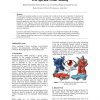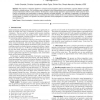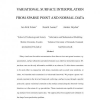7413 search results - page 14 / 1483 » Using Specularities for Recognition |
CGF
2002
13 years 7 months ago
2002
We extend the standard solution to comic rendering with a comic-style specular component. To minimise the computational overhead associated with this extension, we introduce two o...
CVPR
2010
IEEE
14 years 3 months ago
2010
IEEE
We present a practical approach for surface reconstruction of smooth mirror-like objects using sparse reflection correspondences (RCs). Assuming finite object motion with a fix...
TVCG
2008
13 years 7 months ago
2008
We present an interactive algorithm to compute sound propagation paths for transmission, specular reflection and edge diffraction in complex scenes. Our formulation uses an adaptiv...
PAMI
2007
13 years 7 months ago
2007
Many visual cues for surface reconstruction from known views are sparse in nature, e.g. specularities, surface silhouettes and salient features in an otherwise textureless region....
ISVC
2007
Springer
14 years 1 months ago
2007
Springer
Schlick’s approximation of the term xp is used primarily to reduce the complexity of specular lighting calculations in graphics applications. Since moment functions have a kernel...



